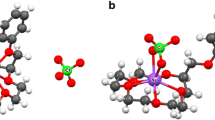Abstract
The ESI–MS and MS/MS behavior of functionalized calix[4]arenes (1–5) has been studied in both positive and negative-ion mode. Liquid chromatography coupled to ESI–MS has been successfully used for separation of the byproducts issuing from the functionalization pathways, through the application of a simple reversed phase mechanism. The ability of (1–5) to host methyl esters of amino acids, tyrosine, tryptophan, phenylalanine, cysteine, valine, serine, leucine, isoleucine, and threonine has been evaluated by means of MS identification of the host–guest resulting in protonated molecular ions. The direct infusion within the ESI source of the solutions containing the two partners (i.e., calixarene and amino acid derivative) could act as a fast screening means for the evaluation of hosting capability. Only positive ionization may offer information about the host–guest complexes being formed. The influence of the excess of a partner in the infused solution strongly alters ionization yields, making quantitative approaches meaningless. Attempts to chromatographically isolate the host–guest complexes failed, probably due to the fact that interactions of the partners with the mobile and stationary phases are higher than the inclusion interactions. Structures consisting of combined fragments of the host–guest partners resulting from the collisional induced dissociation have not been observed.


Similar content being viewed by others
References
Schneider, H.-J., Yatsimirsky, A.: Principles and Methods in Supramolecular Chemistry. Wiley, Chichester (2000)
Schneider, H.-J.: Binding mechanisms in supramolecular complexes. Angew. Chem. Int. Ed. 48, 3924–3977 (2009)
Schalley, C.A.: Molecular recognition and supramolecular chemistry in the gas phase. Mass Spectrom. Rev. 20, 253–309 (2001)
Brodbelt, J.S.: Probing molecular recognition by mass spectrometry. Int. J. Mass Spectrom. 200, 57–69 (2000)
Nibbering, N.M.M.: Four decades of joy in mass spectrometry. Mass Spectrom. Rev. 25, 962–1017 (2006)
Speranza, M.: Enantioselectivity in gas-phase ion-molecule reactions. Int. J. Mass Spectrom. 232, 277–317 (2004)
Speranza, M., Satta, M., Piccirillo, S., Rondino, F., Paladini, A., Giardini, A., Filippi, A., Catone, D.: Chiral recognition by mass-resolved laser spectroscopy. Mass Spectrom. Rev. 24, 588–610 (2005)
Daniel, J.M., Friess, S.D., Rajagopalan, S., Zenobi, R., Wendt, S.: Quantitative determination of noncovalent binding interactions using soft ionization mass spectrometry. Int. J. Mass Spectrom. 216, 1–27 (2002)
Vicenti, M., Irico, A.: Gas-phase interactions of calixarene- and resorcinarene-cavitands with molecular guests studied by mass spectrometry. Int. J. Mass Spectrom. 214, 23–36 (2002)
Stone, M.M., Franz, A.H., Lebrilla, C.B.: Non-covalent calixarene-amino acid complexes formed by MALDI-MS. J. Am. Soc. Mass Spectrom. 13, 964–974 (2002)
Perret, F., Morel-Desrosiers, N., Coleman, A.W.: An ESI/MS study of the formation of ternary 25, 27-bis(dihydroxy-phosphoryloxy)calix[4]arene-metal ion-aminoacid complexes. J. Supramol. Chem. 2, 533–536 (2002)
Torvinen, M., Neitola, R., Sansone, F., Baldini, L., Ungaro, R., Casnati, A., Vainiotalo, P., Kalenus, E.: Glucosylthioureidocalix[4]arenes: synthesis, conformations and gas phase recognition of amino acids. Org. Biomol. Chem. 8, 906–915 (2010)
Bew, S.P., Barter, A.W.J., Sharma, S.V.: Mass spectroscopic investigation of bis-1, 3-urea calix[4]arenes and their ability to complex N-protected α-amino acids. J. Incl. Phenom. Macrocycl. Chem. 66, 195–208 (2010)
Gutsche, C.D.: Calixarenes. The Royal Society of Chemistry, Cambridge (1989)
Böhmer, V., Vicens, J. (eds.): Calixarenes: A Versatile Class of Macrocyclic Compounds. Kluwer Academic Publishers, Dordrecht (1991)
Asfari, Z., Harrowfield, J., Vicens, J. (eds.): Calixarenes 50th Anniversary: Commemorative Volume. Kluwer Academic Publishers, Dordrecht (1994)
Gutsche, C.D.: Calixarenes Revisited. The Royal Society of Chemistry, Cambridge (1998)
Lumetta, G.L., Rogers, R.D., Gopalan, A.S. (eds.): Calixarenes for Separations. ACS Symposium Series 757. American Chemical Society, Washington (2000)
Asfari, Z., Böhmer, V., Harrowfield, J., Vicens, J. (eds.): Calixarenes 2001. Kluwer Academic Publisher, Dordrecht (2001)
Harrowfield, J., Vicens, J. (eds.): Calixarenes in the Nanoworld. Springer, Dordrecht (2007)
Mutihac, L., Buschmann, H.-J., Mutihac, R.-C., Schollmeyer, E.: Complexation and separation of amines, amino acids, and peptides by functionalized calix[4]arenes. J. Incl. Phenom. Macrocycl. Chem. 51, 1–10 (2005)
Danylyuk, O., Suwinska, K.: Solid-state interactions of calixarenes with biorelevant molecules. Chem. Commun. 5799–5813 (2009). doi:10.1039/b910331g
Hamdi, A., Souane, R., Kim, L., Abidi, R., Mutihac, L., Vicens, J.: Extraction behaviour of amino acid esters by functionalized calix[4]arenes. J. Incl. Phenom. Macrocycl. Chem. 64, 95–100 (2009)
Kim, L., Hamdi, A., Stacu, A.D., Souane, R., Mutihac, L., Vicens, J.: Selective membrane transport of amino acids by functionalised calix[4]arenes. J. Incl. Phenom. Macrocycl. Chem. 66, 55–59 (2010)
Hamdi, A., Abidi, R., Trabelsi Ayadi, M., Thuéry, P., Nierlich, M., Asfari, Z., Vicens, J.: Synthesis and cation complexation studies of a new tetra(2-pyridyl)amide calix[4]arene. Tetrahedron Lett. 42, 3595–3598 (2001)
Author information
Authors and Affiliations
Corresponding author
Rights and permissions
About this article
Cite this article
Medvedovici, A., Albu, F., Hamdi, A. et al. Mass spectrometric behavior of functionalized calix[4]arenes: the screening ability of host–guest complex formation with amino acid methyl esters. J Incl Phenom Macrocycl Chem 71, 545–555 (2011). https://doi.org/10.1007/s10847-010-9860-y
Received:
Accepted:
Published:
Issue Date:
DOI: https://doi.org/10.1007/s10847-010-9860-y




